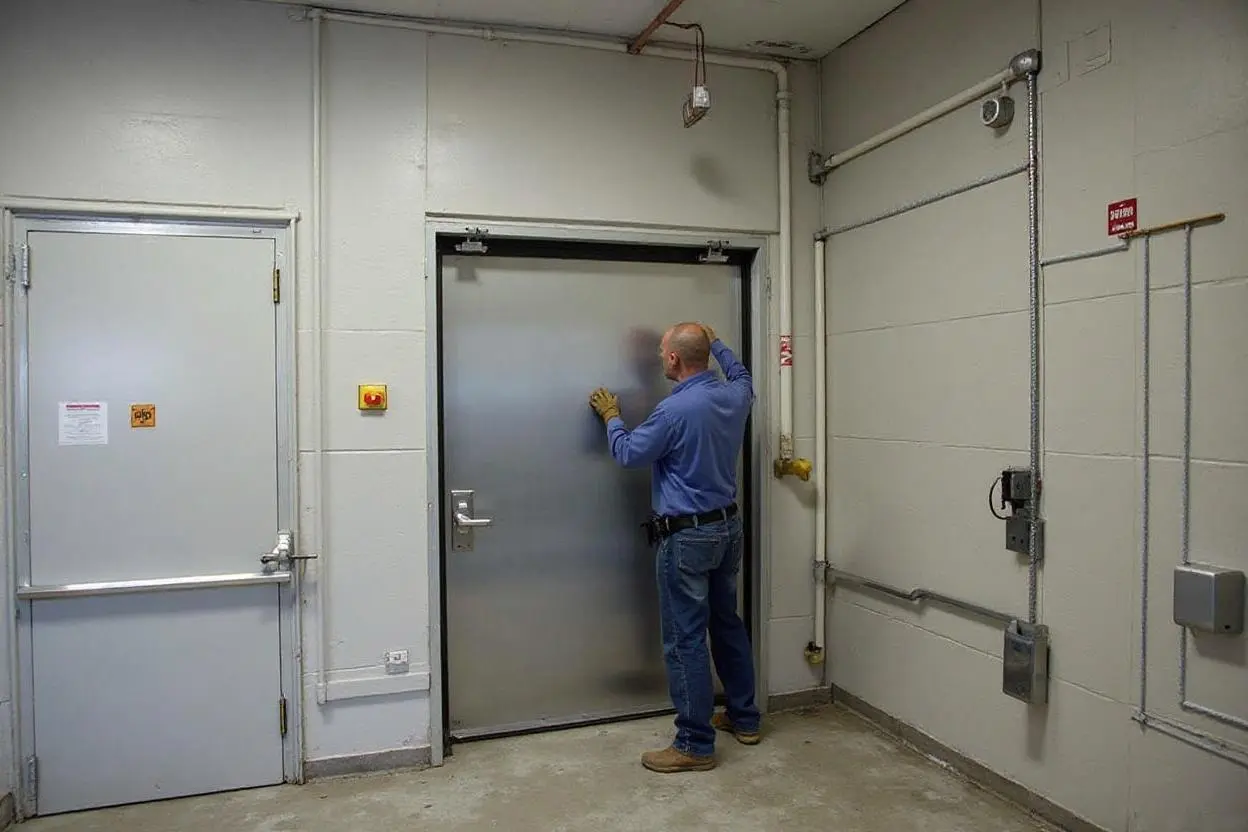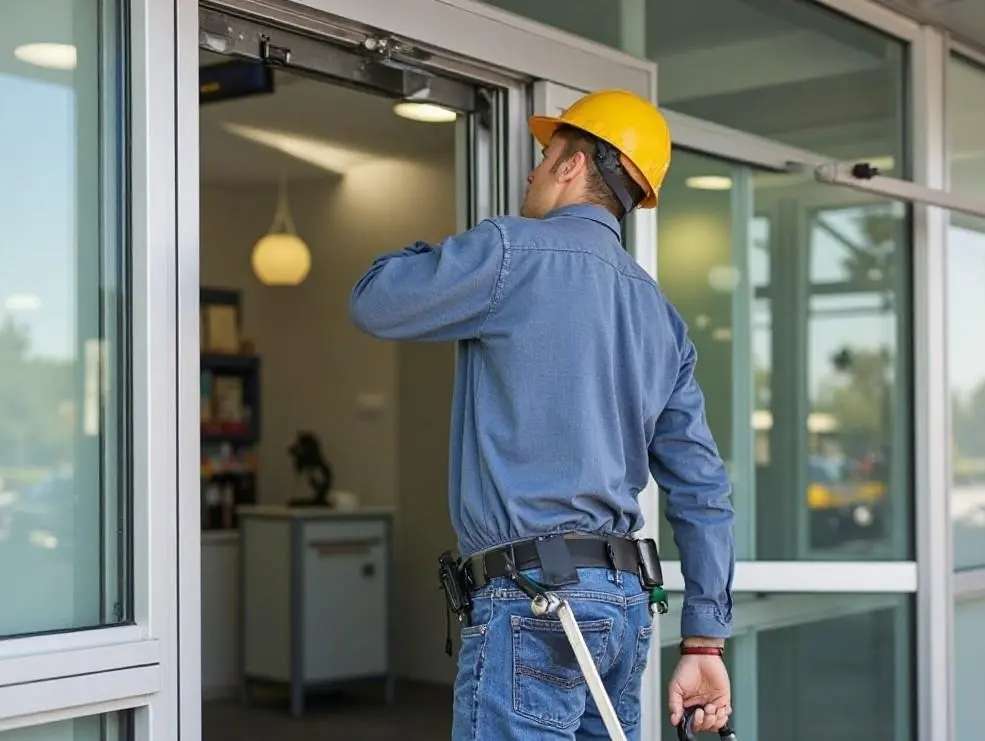Automatic doors keep traffic moving and safety tight, but Buffalo weather makes them work harder than most people think. Lake-effect snow, salt, grit, and freeze-thaw cycles push sensors, motors, and door seals to their limits. A small issue in October can become a shutdown in January. Knowing the early warning signs saves time, protects ADA access, and avoids emergency costs. Here’s what property managers and owners across Buffalo, Amherst, Cheektowaga, Tonawanda, and West Seneca should watch for — and when to call A-24 Hour Door National Inc. for automatic door maintenance.
Slower Opening or Hesitation at Entry
A healthy automatic door opens smoothly and at a consistent speed. If it starts slow, pauses mid-travel, or shudders before moving, there is usually a friction, calibration, or motor issue. In Buffalo, salt dust and grit grind into the track and clutch. In winter, cold thickens grease and exposes weak linkage points. A slowdown that shows up in the morning and improves later in the day often means cold-stiff components or worn lubrication. When the speed varies from day to day, expect sensor drift or control board settings out of range.

Door Closes Too Hard or Bounces Back
A door that slams or rebounds at the jamb is more than annoying; it can be a safety hazard. Pressure settings may be off, safety beams may be misaligned, or the door leaf may be binding due to warped weatherstripping. Buffalo’s temperature swings cause seals to expand and contract. If the door behaves differently after a cold snap or a heat wave, pressure and timing should be checked. A-24 Hour Door National Inc. adjusts closing force to meet ANSI/BHMA A156 standards while keeping foot traffic comfortable.
False Opens and “Ghost” Activation
If the door opens when no one is there, look at sensor contamination or mis-aimed detection zones. Snow flurries, blowing leaves, and reflective puddles can trick older sensors. Interior motion can also trigger doors on vestibule setups common in downtown Buffalo and suburban medical offices. Watch for frequent cycling during storms or early mornings. Cleaning lenses and tightening sensor brackets may fix it; recurring false triggers point to sensor replacement or re-aiming the zones to reduce nuisance openings and heat loss.
Intermittent Beeping, Error Lights, or “Out of Service” Messages
Controllers flag issues before a full failure. If staff silence alarms without logging them, the root cause lingers. A brief beep at power-up can be normal; rapid beeps, flashing LEDs, or recurring reset messages suggest a safety circuit problem, motor overcurrent, or a stuck push plate. On healthcare and retail entrances, error codes often correlate with door count spikes or weather events. Photograph the indicator when it happens and note the time. That detail helps a technician narrow the fault within minutes.
Dragging, Scraping, or Rubbing Sounds
Metal-on-metal noise usually means worn rollers, loose pivots, or track damage. Salt crystals act like sandpaper, wearing nylon rollers down in one season of heavy foot traffic. If the noise changes when the door warms up, look at roller flat spots. If it gets worse after strong winds, check for track misalignment or bent hangers. Left alone, scraping becomes a motor and belt problem, which costs more than replacing a roller set.
Push Plates, Keypads, and Badges That Work “Sometimes”
Intermittent access control issues are common in mixed-use buildings around Elmwood Village and the Medical Campus. Weak power supplies, moisture in junction boxes, or corroded connectors lead to random failures. Winter hats and gloves also change how people hit push plates, revealing loose faceplates and cracked wiring. If the automatic operator runs fine from the service switch but not from the wall plate or badge reader, the problem sits upstream in the trigger circuit.
Door Stalls Mid-Travel
A stall can be a safety response, an obstruction, or a motor overheat. During heavy snow, packed slush builds up in the threshold and tricks the presence sensors or physically blocks the slide. In strip malls along Transit Road, deliveries sometimes bump the guide rail and shift alignment by a quarter inch — enough to halt the door. Repeated stalls risk controller damage. Shut the door down and call for service before the motor cooks.
Drafts, Water Infiltration, and Rising Energy Bills
Automatic doors that “look fine” may still leak. Torn bottom sweeps, flattened pile guides, and missing threshold ramps invite cold air and meltwater. In vestibules, a slight timing mismatch causes both doors to open at once, defeating the airlock. Watch for wet mats, fogged interior glass, or a spike in heating costs after the first freeze. Small weatherstrip fixes pay back fast during a Buffalo winter.
ADA and Safety Concerns: People Get Hesitant
Watch the way people move through your entrance. If seniors pause, wheelchairs struggle to clear the threshold, or kids hesitate, something is off. ADA push-to-open cycles should allow enough time, and the opening width must be consistent. In pediatric clinics and pharmacies, adjust time delays and approach speeds to match real users. A-24 Hour Door National Inc. sees strong results by tuning doors after observing a few peak-traffic cycles.
Glass and Frame Shifts After a Storm
Wind gusts and heaving slabs can rack frames and create rub points. If the gap is wider at the top than the bottom, or the latch edge chips the paint, the frame may be out of square. Sliding doors that “kiss” the sidelite at one spot but not others need track shimming or hanger adjustment. After heavy snowfalls, check for ice buildup under the sill that lifts the track.
Why Buffalo Conditions Demand Routine Automatic Door Maintenance
Buffalo’s maintenance curve is steeper than temperate markets. Average snowfall and road salt create a grinding paste that migrates into operators, rollers, and sensors. Freeze-thaw cycles stress aluminum frames and gaskets. Lake wind finds every opening. Because of that, semiannual service makes sense for most retail, healthcare, and education sites, with quarterly checks for hospitals and grocery stores that see high door counts.
What a Professional Maintenance Visit Looks Like
A-24 Hour Door National Inc. follows a practical routine built for local conditions. The visit starts with a walk test during normal traffic to see real behavior. Technicians clean and re-aim sensors, measure opening and closing speed, and verify safety zones with test objects. They check roller wear, belt tension, and track level; clear thresholds; inspect wiring and connectors; tighten hardware; and recalibrate controls to manufacturer specs. If a component door maintenance is near end-of-life, they explain options with price ranges and lead times so budgeting stays clean.

Quick Owner Checks Between Service Visits
Use this short routine monthly, especially November through March:
- Wipe sensor lenses and push plates with a soft cloth; remove spider webs and salt film. Clear the threshold of grit, ice, and mat edges that roll up into the path. Watch five open-close cycles and note any hesitation, noise, or bounce. Verify the safety beam by passing a box through the path; the door should stop or reopen. Confirm ADA push-to-open timing gives slow walkers enough time to pass.
If anything fails this check, schedule service before snowfall gets heavy.
Common Repairs and Cost Ranges
Most Buffalo storefronts face similar issues. Roller and belt replacements are routine and usually resolved in one visit. Sensor swaps take longer when conduit is corroded or the mounting height changed over time. Weatherstrip kits are quick, but door count and seal type affect price. Emergency calls during a storm can carry premium rates, so catching issues during planned maintenance keeps costs predictable. Many sites reduce unplanned downtime by 30–40% after their first year on a maintenance plan.
A brief field example
A neighborhood pharmacy near Hertel Avenue reported random openings and higher heating bills every afternoon. Sensors were clean, but sunlight reflected off pooled meltwater at the threshold, triggering the approach sensor. The fix was simple: re-aim the detection zone, replace bottom sweeps, and add a narrow threshold ramp to shed water. The door ran quieter, cycling dropped by roughly a third, and the next month’s gas bill fell noticeably.
When to call right away
- The door strikes a person or cart, or fails a safety test. The operator emits burning smells or repeated high-pitched alarms. Glass is cracked, or the frame appears twisted after wind or impact. The door will not secure after hours. A healthcare, school, or grocery entrance stalls during peak traffic.
Immediate service prevents a small fault from becoming a shutdown that hurts revenue or compliance.
Why choose A-24 Hour Door National Inc. in Buffalo
Local experience matters. The team services sliding, swinging, and folding automatic doors across Buffalo, Amherst, Cheektowaga, Tonawanda, Orchard Park, and beyond. Technicians carry common parts on the truck for faster fixes in winter. Scheduling is flexible for early openings and late closings. Clear, simple reporting follows each visit so managers know what was done, what’s next, and how to budget. The focus is straightforward: keep entrances safe, compliant, and reliable in Buffalo conditions.
Ready to get ahead of winter issues? Request automatic door maintenance with A-24 Hour Door National Inc. today. A brief site review and a smart maintenance plan go a long way in Buffalo, NY.
A-24 Hour Door National Inc provides commercial and residential door repair in Buffalo, NY. Our technicians service and replace a wide range of entry systems, including automatic business doors, hollow metal frames, storefront entrances, fire-rated steel and wood doors, and both sectional and rolling steel garage doors. We’re available 24/7, including holidays, to deliver emergency repairs and keep your property secure. Our service trucks arrive fully stocked with hardware, tools, and replacement parts to minimize downtime and restore safe, reliable access. Whether you need a new door installed or fast repair to get your business back up and running, our team is ready to help.
A-24 Hour Door National Inc
344 Sycamore St
Buffalo,
NY
14204,
USA
Phone: (716) 894-2000
Website: https://a24hour.biz/buffalo
Instagram: @a24hourdoor
Facebook: 24 Hour Door
Yelp: A-24 Hour Door National (Buffalo)
X (Twitter): @a24hrdoor